Daniel Conrad (born 1946) is an American light-artist, painter, sound artist, teacher and writer from Baltimore County, Maryland.
Conrad began his light-work in the late 1960s in response to his reading of Josef Albers’ Interaction of Color while at Amherst College. His experimental film Circles (16mm, 1969) explored color afterimage. While in the San Francisco Bay Area in the early 1970s, he created a colored light performance instrument, derived from concepts of color perception, very different from the psychedelic light shows of that period. This color machine used multiple bulbs with color gels in housings that Conrad fabricated arranged behind a rear-projection screen and controlled by dimmers. Conrad performed in the Bay Area as a "visual musician" with musician Jordan de la Sierra and played in poet Daniel Moore's Floating Lotus Magic Opera Company. Later in the 70s, having returned to Baltimore County, Maryland, Conrad studied at the Maryland Institute College of Art, where he earned an MFA from The Hoffberger School of Painting under Grace Hartigan in 1981.
The term “chromaccord”, meaning “colors-together”, was coined by Conrad in 1999 when he built a refined version of his color machine. Conrad wrote that the chromaccord is "an instrument designed to manipulate kinetic color designed to invoke visual responses. It places an area of color (the object) on a background of another color (the surround). The instrument is performed by changing the color areas. [...] By using such an arrangement, the chromaccord becomes a tool for exploring the visual experience of continually changing sequential and simultaneous contrasts." As a performer of the chromaccord, he has often collaborated with musicians and sound artists, including Ian Nagoski, John Berndt, Neil Feather, Jorge Martins, and Andrew Hayleck. Significant exhibitions of the color-instrument have included performances at the High Zero Festival and the Diapason Gallery. Efforts to apply the principles of the chromaccord to midi-controlled digital projection culminated in the spring of 2009 with a performance at the Baltimore Museum of Art with sound artist Andrew Hayleck.
Since 1998 Conrad has made self-operating color-changing “light paintings” that capture some of the qualities of the chromaccord instrument using various types of internal control circuitry.
Conrad is also an inventor and player of original musical instruments including a vibrating metal device, Wild Wave, and a floating-bridge monochord, Veena Bambeena. He is also vocalist and songwriter in the duo Yoinsh with guitarist Jorge Martins, who self-released a compact disc in 2012, and was a member of The Lum & Abner of Morocco who contributed a track to the 2-CD set More Self is Less Self on the Ecstatic Peace label.
His father Arthur Conrad, a portrait painter whose work hangs in the U.S. Senate reception room, worked with Everett Warner during World War II in designing camouflage for the US Navy. His brother Tony Conrad was a video artist, filmmaker and musician.

Op art, short for optical art, is a style of visual art that uses optical illusions.

Anders Leonard Zorn was a Swedish painter. He attained international success as a painter, sculptor, and etching artist. Among Zorn's portrait subjects include King Oscar II of Sweden and three American Presidents: Grover Cleveland, William H. Taft, and Theodore Roosevelt. At the end of his life, he established the Swedish literary Bellman Prize in 1920.

Anthony Schmalz Conrad was an American video artist, experimental filmmaker, musician, composer, sound artist, teacher, and writer. Active in a variety of media since the early 1960s, he was a pioneer of both drone music and structural film. As a musician, he was an important figure in the New York minimalist scene of the early 1960s, during which time he performed as part of the Theatre of Eternal Music. He became recognized as a filmmaker for his 1966 film The Flicker. He performed and collaborated with a wide range of artists over the course of his career.

The School of the Museum of Fine Arts at Tufts University is the art school of Tufts University, a private research university in Boston, Massachusetts. It offers undergraduate and graduate degrees dedicated to the visual arts.

Luigi Carlo Filippo Russolo was an Italian Futurist painter, composer, builder of experimental musical instruments, and the author of the manifesto The Art of Noises (1913). Russolo completed his secondary education at Seminary of Portograuro in 1901, after which he moved to Milan and began gaining interest in the arts. He is often regarded as one of the first noise music experimental composers with his performances of noise music concerts in 1913–14 and then again after World War I, notably in Paris in 1921. He designed and constructed a number of noise-generating devices called Intonarumori.
The term color organ refers to a tradition of mechanical devices built to represent sound and accompany music in a visual medium. The earliest created color organs were manual instruments based on the harpsichord design. By the 1900s they were electromechanical. In the early 20th century, a silent color organ tradition (Lumia) developed. In the 1960s and 1970s, the term "color organ" became popularly associated with electronic devices that responded to their music inputs with light shows. The term "light organ" is increasingly being used for these devices; allowing "color organ" to reassume its original meaning.
The Washington Color School, also known as the Washington, D.C., Color School, was an art movement starting during the 1950s–1970s in Washington, D.C., in the United States, built of abstract expressionist artists. The movement emerged during a time when society, the arts, and people were changing quickly. The founders of this movement are Morris Louis and Kenneth Noland, however four more artists were part of the initial art exhibition in 1965.
Visual music, sometimes called color music, refers to the creation of a visual analogue to musical form by adapting musical structures for visual composition, which can also include silent films or silent Lumia work. It also refers to methods or devices which can translate sounds or music into a related visual presentation. An expanded definition may include the translation of music to painting; this was the original definition of the term, as coined by Roger Fry in 1912 to describe the work of Wassily Kandinsky. There are a variety of definitions of visual music, particularly as the field continues to expand. In some recent writing, usually in the fine art world, visual music is often confused with or defined as synaesthesia, though historically this has never been a definition of visual music. Visual music has also been defined as a form of intermedia.
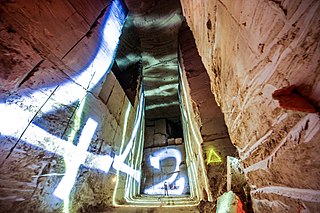
Light painting, painting with light,light drawing, or light art performance photography are terms that describe photographic techniques of moving a light source while taking a long-exposure photograph, either to illuminate a subject or space, or to shine light at the camera to 'draw', or by moving the camera itself during exposure of light sources. Practiced since the 1880s, the technique is used for both scientific and artistic purposes, as well as in commercial photography.
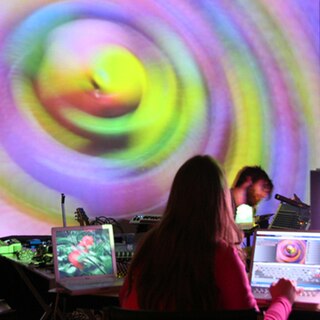
VJing is a broad designation for realtime visual performance. Characteristics of VJing are the creation or manipulation of imagery in realtime through technological mediation and for an audience, in synchronization to music. VJing often takes place at events such as concerts, nightclubs, music festivals and sometimes in combination with other performative arts. This results in a live multimedia performance that can include music, actors and dancers. The term VJing became popular in its association with MTV's Video Jockey but its origins date back to the New York club scene of the 1970s. In both situations VJing is the manipulation or selection of visuals, the same way DJing is a selection and manipulation of audio.
The phrase synesthesia in art has historically referred to a wide variety of artists' experiments that have explored the co-operation of the senses in the genres of visual music, music visualization, audiovisual art, abstract film, and intermedia. The age-old artistic views on synesthesia have some overlap with the current neuroscientific view on neurological synesthesia, but also some major differences, e.g. in the contexts of investigations, types of synesthesia selected, and definitions. While in neuroscientific studies synesthesia is defined as the elicitation of perceptual experiences in the absence of the normal sensory stimulation, in the arts the concept of synaesthesia is more often defined as the simultaneous perception of two or more stimuli as one gestalt experience. The usage of the term synesthesia in art should, therefore, be differentiated from neurological synesthesia in scientific research. Synesthesia is by no means unique to artists or musicians. Only in the last decades have scientific methods become available to assess synesthesia in persons. For synesthesia in artists before that time one has to interpret (auto)biographical information. For instance, there has been debate on the neurological synesthesia of historical artists like Kandinsky and Scriabin. Additionally, Synesthetic art may refer to either art created by synesthetes or art created to elicit synesthetic experience in the general audience.

Mel Alexenberg is an American-Israeli artist, art educator, and writer recognized for his pioneering work exploring the intersections of art, science, technology and digital culture. He created the first digital computer generated painting in 1965, experimental digital fine art prints in the 1980s that are in 30 museum collections worldwide, circumglobal cyberangel flights honoring Rembrandt in 1989 and in 2019.

Painting is a visual art, which is characterized by the practice of applying paint, pigment, color or other medium to a solid surface. The medium is commonly applied to the base with a brush, but other implements, such as knives, sponges, and airbrushes, can be used.

Light art or the art of light is generally referring to a visual art form in which (physical) light is the main, if not sole medium of creation. Uses of the term differ drastically in incongruence; definitions, if existing, vary in several aspects. Since light is the medium for visual perception, this way all visual art could be considered light art absurdly enough; but most pieces of art are valid and coherent without reflecting on this basic perceptual fact. Some approaches on these grounds also include into light art those forms of art where light is not any medium contributing to the artwork, but is depicted. Thus, luminism may also refer to light art in the above sense, its previous usage point to painterly styles: either as an other label for the Caravaggisti in the baroque, or 19th and 20th centuries, fundamentally impressionist schools.
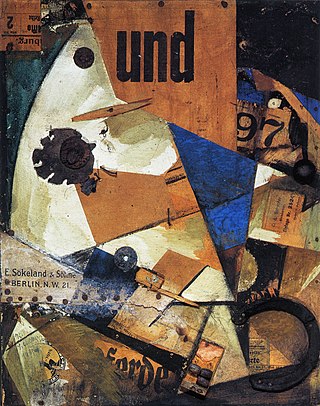
Collage is a technique of art creation, primarily used in the visual arts, but in music too, by which art results from an assemblage of different forms, thus creating a new whole.
George Smits, aka 'Toet', was a Belgian visual artist, comics artist, radio presenter, experimental musician and inventor of experimental musical instruments.

Mike Riley is an American cartoonist and comic book writer currently residing in Baltimore, Maryland. He is best known as the creator of the single-panel webcomic I Taste Sound and the comic series Irregulordz.
Norman Perryman was born in Birmingham, England in 1933, was educated at the Worcester Royal Grammar School, and studied painting and art education at the Birmingham College of Art and Crafts, graduating with Honours in 1954. He emigrated to the Netherlands in 1957, then moved to Switzerland. He was Head of Art at Aiglon College (1967–73) and from 1976–1990 was Chief Examiner for the Visual Arts programme of the International Baccalaureate, designing and developing the Visual Art curriculum and traveling worldwide to give workshops on the role of the arts in education and the relationships of the visual arts and music. He returned to Holland in 1978 and now lives in Amsterdam.
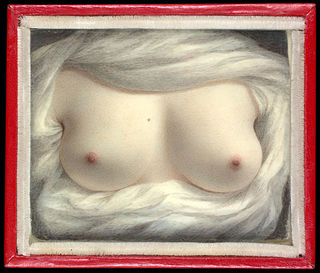
Beauty Revealed is an 1828 self-portrait by the American artist Sarah Goodridge, a watercolor portrait miniature on a piece of ivory. Depicting only the artist's bared breasts surrounded by white cloth, the 6.7-by-8-centimeter painting, originally backed with paper, is now in a modern frame. Goodridge, aged forty when she completed the miniature, depicts breasts that appear imbued with a "balance, paleness, and buoyancy" by the harmony of light, color, and balance. The surrounding cloth draws the viewer to focus on them, leading to the body being "erased".
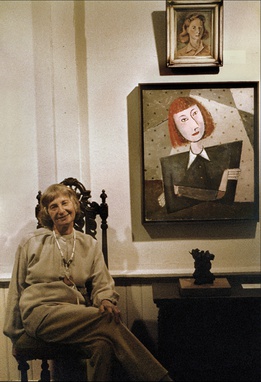
Amalie Rothschild (1916–2001) was an American artist who lived and worked within the art community of Baltimore, Maryland. An accomplished painter and sculptor, she was also an art teacher, philanthropist, patron, and cultural advocate. Over the course of a long career, she made oil and acrylic paintings as well as drawings, watercolors, and other paper works. She also sculpted using found objects, Plexiglas, metals, and particleboard. Originally working in a realist style, she became well known for geometric abstractions based on figurative subjects. In 1993 a critic described this approach as "[walking] a tightrope between the abstract and the representational with a suggestion of three-dimensional depth." Rothschild was by choice a regional artist. Although she occasionally exhibited elsewhere, she did not actively promote her career outside a mid-Atlantic region centered on Baltimore. Thus, in 1997 a critic wrote, "Amalie Rothschild is a fixture and ornament of the Baltimore art world." At the time of her death a critic gave this career summary: "She was one of the leading artists of her time in this area. Her work is thoroughly modern and related to geometric abstraction, but without losing the figure. It has emotional reserve, often contains a hint of humor and at times recalls the childlike sagacity of the great Paul Klee."